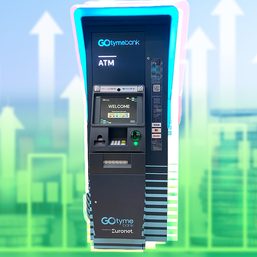SUMMARY
This is AI generated summarization, which may have errors. For context, always refer to the full article.
![[Finterest] How deposit insurance keeps your money safe when a bank closes](https://www.rappler.com/tachyon/2022/09/shutterstock-philippine-peso.jpg)
MANILA, Philippines – In 2023, the successive failures of two high-profile banks in the United States – Silicon Valley Bank (SVB) and Signature Bank – rocked global markets and showed how financial institutions can quickly crumble when trust is lost.
SVB failed partly due to a social media-driven bank run that saw its depositors withdraw $42 billion in just 24 hours, stretching the bank beyond its breaking point. In a bid to restore trust in the banking system, US authorities decided to guarantee the entire deposits of all SVB clients, even for amounts beyond the maximum government-insured level.
The Philippines was spared from the fallout of the banking woes in the US, but bank failures have happened several times in the country’s past. So is your money really safe in a bank, and how can you get it back when a bank closes?
This is where the government-owned Philippine Deposit Insurance Corporation (PDIC) comes in. The PDIC guarantees the savings of a depositor up to a certain amount in the unlikely event of a bank closure.
What PDIC covers and what it doesn’t
Currently, the PDIC provides a maximum deposit insurance coverage (MDIC) of P500,000 per depositor, per bank. That covers a range of deposit account types, such as savings, special savings, time deposits, demand and checking, and negotiable order of withdrawal.
The PDIC covers deposit accounts in all banks licensed by the Bangko Sentral ng Pilipinas (BSP), whether they are local universal, commercial, thrift, or rural banks, and including foreign banks that have branches in the Philippines. (READ: [Finterest] What exactly does a bank do, and how can they help you?)
Although the PDIC covers a broad range of financial institutions, not everything is guaranteed by the government.
“There are certain financial institutions that are not covered by deposit insurance. Basically, they are not banks, so they are not covered by the protection offered by the PDIC. This includes cooperatives and savings and loan associations that are considered non-stock,” Jose Villaret, PDIC vice president of the corporate affairs group, said in a press conference on Friday, June 7.
Crucially, the balances kept in popular e-wallets such as GCash and Maya Wallet are not currently covered by PDIC’s deposit insurance since they don’t qualify as deposits. On top of this, Villaret explained that most users were using e-wallets for transactions and not savings. However, the PDIC official said that the possibility of providing some form of protection or cover for e-wallets is “being studied.”
Computing your insured deposits
When a bank is closed down, the PDIC takes over and begins liquidating it by collecting the remaining loans and disposing of assets. It also pays affected depositors up to the maximum amount insured.
How do you compute this? First off, the PDIC separately insures single and joint accounts. That means all single deposit accounts in your name under the same bank are insured up to a total of P500,000.
Meanwhile, if you have other joint accounts in the same bank, then you are also insured up to P500,000 in total for your share in the joint account. PDIC divides the deposit insurance of a joint account equally among owners unless clients have stipulated a different sharing agreement with the bank.
Let’s make things clearer with some examples provided by the PDIC.

The above table shows how all single deposit accounts under the same name are totaled together; PDIC then insures those total deposits up to P500,000. That means that Maria Cruz, for example, has P200,000 of uninsured deposits because her total deposits of P700,000 exceeds the PDIC’s limit.

For joint accounts, only P500,000 of the account’s outstanding balance is insured. For instance, in the joint “Juan Cruz & Maria Cruz & Pedro Cruz” account, only P500,000 of the P700,000 is insured by the PDIC. The insured amount is then divided equally among accountholders, unless otherwise stipulated. If a depositor has multiple joint accounts, like in the example above, their shares in the insured amount of each account is totaled up to a limit of again P500,000.
Note that if you still have due loans with the bank at the time that it closed down, then the payments for those loans will be deducted from your insured deposits.
The PDIC claims that it has sped up its processes and can hand out insured deposits in as quickly as 14 days.
“As of now, the earliest that you can get your deposit insurance is 14 days. The latest would be 21 days. We’ve improved our processes from the time in 2000 where your payment can be received months after,” said Adalzon Banogon, PDIC vice president of the deposit insurance sector.
You can also use the PDIC’s calculator to estimate your deposit insurance.
Is P500,000 really enough?
Currently, the PDIC covers 480 banks across the country. As of end-2023, deposits in PDIC member banks total to P18.98 trillion across 121.60 million accounts.
Of this nearly P19 trillion in deposits, only 18.54% or less than a fifth of the total deposits in the country are covered by the PDIC. While that might sound alarming at first, the PDIC says that 97.4% of all deposit accounts are fully insured.
PDIC officials explained that this is because the majority of deposit accounts in the Philippines, especially those in rural banks, fall below the P500,000 maximum deposit insurance level. But this also implies that the bulk of deposits are concentrated in a relatively few accounts that are well over that measly P500,000-MDIC. If a bank fails, it’s these bigger depositors who could feel the burn.
The P500,000-MDIC was set about 15 years ago in 2009 as a result of a study by the PDIC technical team and Congress. Asked by Rappler whether the PDIC plans to increase this deposit insurance cap, officials said that there have been such talks since last year.
“Right now, there are studies on increasing the maximum deposit insurance coverage. And as of now, we cannot yet announce up to how much it will increase because we will still seek the comments of the Bangko Sentral and the banking associations in the country,” Sandra Diaz, PDIC senior vice president of the management services sector, said on Friday, June 7. – Rappler.com
Finterest is Rappler’s series that demystifies the world of money and gives practical advice on how to manage your personal finance.
Add a comment
How does this make you feel?
![[Vantage Point] How safe is our money in banks?](https://www.rappler.com/tachyon/2023/03/Banks-TL_March-28-2023.jpg?fit=449%2C449)

![[Finterest] Private banking: How the wealthy keep the money within the family](https://www.rappler.com/tachyon/2024/07/Finterest-wealth-between-the-family.jpg?resize=257%2C257&crop=425px%2C0px%2C1080px%2C1080px)
![[Finterest] Credit card 101: How does it work, and which one is for you?](https://www.rappler.com/tachyon/2024/06/credit-card-stock-photo.jpg?resize=257%2C257&crop_strategy=attention)
![[Finterest] How to earn on TikTok Shop, according to the app’s top vendors](https://www.rappler.com/tachyon/2024/05/tiktok-shop-top-vendors-1.jpg?resize=257%2C257&crop=310px%2C0px%2C720px%2C720px)


There are no comments yet. Add your comment to start the conversation.